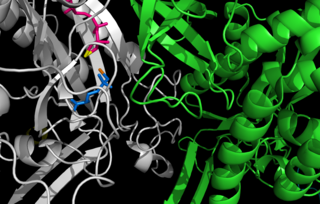| glutamin-(asparagin-)ase | |||||||||
|---|---|---|---|---|---|---|---|---|---|
| Identifiers | |||||||||
| EC no. | 3.5.1.38 | ||||||||
| CAS no. | 39335-03-0 | ||||||||
| Databases | |||||||||
| IntEnz | IntEnz view | ||||||||
| BRENDA | BRENDA entry | ||||||||
| ExPASy | NiceZyme view | ||||||||
| KEGG | KEGG entry | ||||||||
| MetaCyc | metabolic pathway | ||||||||
| PRIAM | profile | ||||||||
| PDB structures | RCSB PDB PDBe PDBsum | ||||||||
| Gene Ontology | AmiGO / QuickGO | ||||||||
| |||||||||
This article includes a list of references, related reading, or external links, but its sources remain unclear because it lacks inline citations .(December 2024) |
In enzymology, a glutamin-(asparagin-)ase (EC 3.5.1.38) is an enzyme that catalyzes the chemical reaction
- L-glutamine + H2O L-glutamate + NH3
Thus, the two substrates of this enzyme are L-glutamine and H2O, whereas its two products are L-glutamate and NH3.
This enzyme belongs to the family of hydrolases, those acting on carbon-nitrogen bonds other than peptide bonds, specifically in linear amides. The systematic name of this enzyme class is L-glutamine(L-asparagine) amidohydrolase. This enzyme participates in 4 metabolic pathways: glutamate metabolism, alanine and aspartate metabolism, d-glutamine and d-glutamate metabolism, and nitrogen metabolism.







